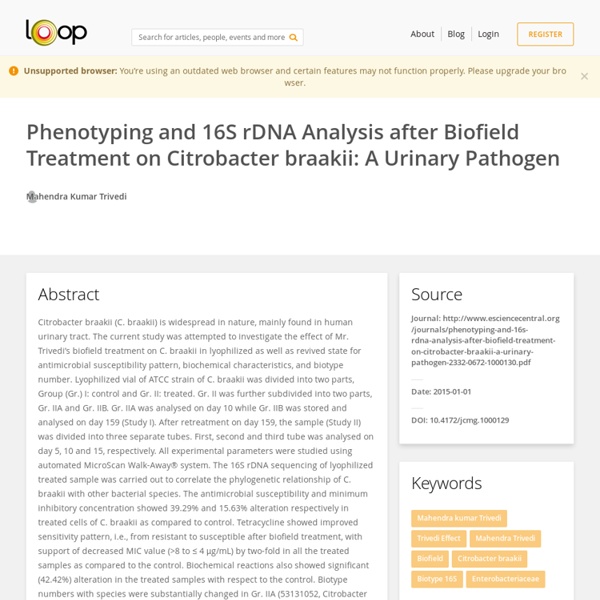



http://loop.frontiersin.org/publications/43566804
Phenotyping Analysis of Citrobacter Braakii after Biofield Treatment Description Citrobacter braakii (C. braakii) is widespread in nature, mainly found in human urinary tract. The current study was attempted to investigate the effect of Mr. Study of Biochemical Characteristics of Citrobacter Braakii Research Article Open Access Trivedi et al., J Clin Med Genom 2015, 3:1 Volume 3 • Issue 1 • 1000129 J Clin Med Genom Impact of Biofield Treatment on Methyl-2-Naphthyl Ether Abstract Methyl-2-naphthyl ether (MNE) is an organic compound and used as the primary moiety for the synthesis of several antimicrobial and anti-inflammatory agents. This study was attempted to evaluate the impact of biofield energy treatment on the physical, thermal, and spectroscopic properties of MNE.
Phenotyping and 16S rDNA Analysis after Biofield Treatment on Citrobacter braakii: A Urinary Pathogen Citrobacter braakii (C. braakii) is widespread in nature, mainly found in human urinary tract. The current study was attempted to investigate the effect of Mr. Trivedi’s biofield treatment on C. braakii in lyophilized as well as revived state for antimicrobial susceptibility pattern, biochemical characteristics, and biotype number. Lyophilized vial of ATCC strain of C. braakii was divided into two parts, Group (Gr.) I: control and Gr. II: treated. 16s rDNA Sequencing of Human Energy Treated C. Braakii Title: Phenotyping and 16S rDNA Analysis after Biofield Treatment on Citrobacter braakii: A Urinary Pathogen Publication: Journal of Clinical & Medical Genomics
Citrobacter Braakii – Study of Biochemical Characteristics Abstract Citrobacter braakii (C. braakii) is widespread in nature, mainly found in human urinary tract. The current study was attempted to investigate the effect of Mr. Trivedi’s biofield treatment on C. braakii in lyophilized as well as revived state for antimicrobial susceptibility pattern, biochemical characteristics, and biotype number. Lyophilized vial of ATCC strain of C. braakii was divided into two parts, Group (Gr.)
The Science Behind The Trivedi Effect® Atoms exist in all states of matter. Even the cells of microbes, plants, human beings and all other living / non-living things consist entirely of atoms in the form of complex molecules. Atoms, at the most elementary level, are made from electrons, protons, neutrons and several known and unknown subatomic particles. Physicists and chemists hypothesize several theories to explain the systematic and disciplinary existence of various species inside the atom, the nature of bonds between atoms in condensed states (such as solids and liquids), as well as for the way the particles are working inside the atom. There have been several attempts to develop a unified picture that links the macroscopic universe and the microscopic atomic and subatomic world.
The Potential Impact of Biofield Treatment on Human Brain Tumor Cells: A Time-Lapse Video Microscopy Abstract Study background: Glioblastoma (GBM) is the most common subtype of primary brain tumor in adults. The aim was to evaluate the impact of biofield treatment potential on human GBM and non-GBM brain cells using two time-lapse video microscopy technique. Methods: The human brain tumor, GBM cultured cells were divided into two groups viz. GBM control and GBM treatment. Similarly, human normal brain cultured cells (non-GBM) were taken and divided into two groups viz. non- GBM control and non-GBM treatment. Antimicrobial Susceptibility Testing of Burkholderia Cepacia Abstract Burkholderia cepacia (B. cepacia) is an opportunistic, Gram negative pathogen which causes infection mainly in immunocompromised population and associated with high rate of morbidity and mortality in cystic fibrosis patients. Aim of the present study was to analyze the impact of biofield treatment on multidrug resistant B. cepacia. Clinical sample of B. cepacia was divided into two groups i.e. control and biofield treated. The analysis was done after 10 days of treatment and compared with control group.
Burkholderia Cepacia Antimicrobial Susceptibility Testing An Effect of Biofield Treatment on Multidrug-resistant Burkholderia cepacia: A Multihost Pathogen Mahendra Kumar Trivedi , Shrikant Patil Impact of Human Biofield Energy on 1,2,3-Trimethoxybenzene Abstract Study background: 1,2,3-Trimethoxybenzene is an important compound used for the synthesis of chemicals and pharmaceutical agents. The objective of this study was to investigate the influence of biofield energy treatment on the physical, thermal and spectral properties of 1,2,3-trimethoxybenzene. Methods: The study was performed by dividing the sample into two groups (control and treated). The control group remained as untreated, while the treated group received Mr Trivedi’s biofield energy treatment. The control and treated 1,2,3-trimethoxybenzene samples were then characterized by X-ray diffraction (XRD), differential scanning calorimetry (DSC), thermogravimetric analysis (TGA), Fourier transform infrared (FT-IR) spectroscopy, and ultra violetvisible spectroscopy (UV-Vis) analysis.